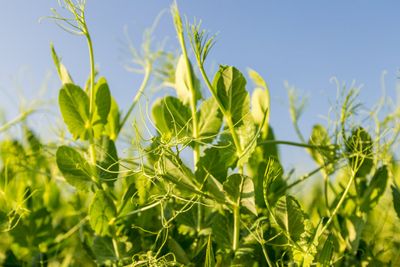Reasons for Garden Peas Not Producing
Here are the top reasons why a pea plant may not be growing or producing as it should:
Too Much Nitrogen
Nitrogen is one of the macronutrients plants need. In the case of peas, more is not better. Peas are legumes, and these types of plants have the ability to take nitrogen from the atmosphere and convert it into a form used by plants. Legumes can even add nitrogen to the soil. When peas are all foliage with little or no blossom development, too much nitrogen is often the problem. Solution: Have the garden soil tested and only apply fertilizer if nitrogen levels are low. Use a low nitrogen fertilizer like 5-10-10 around the peas. To save this year’s pea crop, pinch back the growing tips to encourage blossom development.
Too Little Nitrogen
Nutrient deficiencies can cause low plant vigor and decreased yields. If legumes fix nitrogen, how can peas become nitrogen deficient? Simple. The process of nitrogen-fixing in legumes is a symbiotic one with a specific bacterium, Rhizobium leguminosarum. If your garden soil is lacking this bacterium, you’ll experience poor growing pea plants with no pods. Solution: Compost pea plants directly in the garden after harvest. The nitrogen formed in the root nodules will be available for the next crop of vegetables and the needed bacteria will remain in the soil. First-time pea growers can introduce the correct bacteria into the garden by purchasing pea seeds inoculated with Rhizobium leguminosarum.
Other Nutritional Deficiencies
In addition to the correct nitrogen levels, peas require other macro and micronutrients. For instance, phosphorus is needed for root and flower formation as well as the development of fruit and sugar levels in peas. If your plants are growing poorly and producing no pea pods, nutritional deficiency could be the cause. Solution: Test the soil and amend or fertilize as needed.
Poor Pollination
If your pea plants are healthy and producing an abundance of blossoms, but the pea pods won’t form, then poor pollination may be the culprit. Peas pollinate by two methods, self-pollination before the flowers open and cross-pollination by bees or other insects. Pollination problems are usually confined to peas grown in a tunnel house or protected environment. Solution: Give the pea plants a little shake during the blooming period to distribute pollen or use a fan indoors to create air flow and stimulate self-pollination.
Poor Growing Conditions
Any number of poor growing conditions can also attribute to garden peas not producing. Cold, wet springs or hot, dry weather can impede the development of root nodules and inhibit nitrogen fixing. Planting peas too late in the season can cause the plants to turn yellow and die before setting pods. Dry conditions due to lack of rain and supplemental watering during flowering and pod production can result in plants with few or no pea pods. Solution: Peas are a cool-season crop. Choose a variety that does well in your climate. Plant in early spring for a summer crop or late summer for a fall crop. Water when rainfall is less than 1 to 2 inches (2.5-5 cm.) per week.
